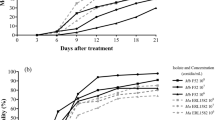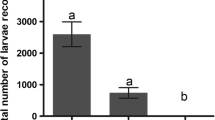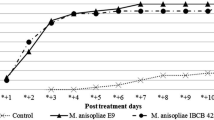Abstract
When ticks were sealed in nylon tetrapacks and infected with the entomogenous fungi, Beauveria bassiana and Metarizium anisopliae and maintained in potted grass in the field, the fungal oil formulations (109 conidia per ml) induced 100% mortality in larvae of Rhipicephalus appendiculatus and Amblyomma variegatum, whereas mortalities in nymphs varied between 80–100% and in adults 80–90%. The aqueous formulations (109 conidia per ml) induced mortalities of 40–50% and reductions in egg hatchability of 68% (B. bassiana) and 48% (M. anisopliae) when sprayed on Boophilus decoloratus engorging on cattle. The strains of B. bassiana and M. anisopliae isolated from naturally infected ticks were also found to induce high mortalities in both R. appendiculatus and A.variegatum in tetrapacks placed in potted grass. Both aqueous and oil-based formulations were found to be effective, although the latter induced higher mortalities. These fungal strains in aqueous formulation (108 conidia per ml) suppressed on-host populations of adult R. appendiculatus by 80% (B. bassiana) and 92% (M. anisopliae) when sprayed on tick-infested grass once per month for a period of 6 months. The feasibility of using entomogenous fungi for tick control in the field is discussed.
Similar content being viewed by others
References
Backer, G.L., Milner, R.J., Lutton, G.G. and Watson, D.M. 1994. Preliminary field trial on the control of Phaulacridium vittatum (sjostedt Orthoptera: Acrididae) populations with Metarhizium flavoviride Gams and Rozsypal (Deuteromycotina: Hyphomycetes). J. Austr. Entomol. Soc. 33: 190–192.
De Castro, J.J. 1997. Sustainable ticks and tick-borne disease control in livestock improvement in developing countries. Vet. Parasitol. 71: 69–76.
Fargues, J. and Remaudiere, G. 1977. Consideration on the specificity of entomopathogenic fungi. Mycopathologia. 62: 31–41.
Gillespie, A.T. and Claydon, N. 1989. The use of entomogenous fungi for pest control and the role of toxins in pathogenesis. Pesticide Sci. 27: 203–215.
Goettel, M.S. and Johnson, D.L 1992. Environmental impact and safety of fungal biocontrol agents, In: Biological Control of Locusts and Grasshoppers, C.J. Lomer and C. Prior (eds), pp. 356–361 CAB International, Wallingford, UK.
Hooper, G.H.S., Milner, RJ., Spurgin, P.A. and Prior, C. 1995. Initial field assessment of Metarhizium flavovirideGams and Rozsypal (Deuteromycetina: Hyphomycetes) for control of Chortoicetes terminifera (Walker) (Orthoptera: Acrididae). J. Aust. Ent. Soc. 34: 83–84.
Jongejan, F., Pegram, R.G., Zivkovic, D., Hensen, E.J., Mwase, E.T., Theilemans, M.J.C., Cosse, A., Niewold, T.A. Ashraf ElSaid and Uilenberg, G. 1989. Monitoring of naturally acquired and artificially induced immunity to Amblyomma variegatum and Rhipicephalus appendiculatus ticks under field and laboratory conditions. Exp. Appl. Acarol. 7: 181–199.
Kaaya, G.P. 1989. Glossina morsitans morsitans: Mortalities caused in adults by experimental infection with entomopathogenic fungi. Acta Trop. 46: 107–114.
Kaaya, G.P. and Okech, M.A. 1990. Horizontal transmission of mycotic infection in adult tsetse, Glossina morsitans morsitans. Entomophaga 35: 46–57.
Kaaya, G.P. and MunyinyiI, D. 1995. Biocontrol potentials of the entomogenous fungi Bauveria bassiana and Metarhizium anisopliae for tsetse flies, Glossina spp. at developmental sites. J. Invert. Pathol. 66: 237–241.
Kaaya, G.P., Mwangi, E.N. and Ouna, E.A. 1996. Prospects for biological control of livestock ticks, Rhipicephalus appendiculatus and Amblyomma variegatum using the entomogenous fungi Beauveria bassiana and Metarhizium anisopliae. J. Invert. Pathol. 67: 15–20.
Kaaya, G.P. and Mwangi, E.N. 1998. Control of livestock ticks in Africa: Possibilities of biological control using the entomogenous fungi, Beauveria bassiana and Metarhizium anisopliae. In: The second International Conference on tick-borne Pathogens at the Hostvector Interface: A Global Perspective, L. Coons and M. Rothschild (eds). August, 28-September 1, Kruger National Park, South Africa, pp. 5–16, United Litho.
Lomer, C.J., Prior, C and Kooyman, C. 1997. Development of Metarhizium spp. for the control of grasshoppers and locusts. Mem. Entomol. Soc. Canada 171: 265–286.
Maniania, N.K. 1993. Effectiveness of the entomopathogenic fungus Beauveria bassiana (Bals.) Vuill. for the control of the stem borer Chilo partellus in maize in Kenya. Crop Protect. 12: 601–604.
Milner, R.J., Hartley, T.R., Lutton, G.G and Prior, C. 1994. Control of Phaulacridium vittatum (sjostedt) (Orthoptera: Acrididae) in field cages using an oil-based spray ofMetarhizium flavoviride Gams and Rozsypal (Deuteromycetina: Hyphomycetes). J. Austr. Entomol. Soc. 33: 165–167.
Munaan, A. and Wikardi, E.A. 1986. Towards the biological control of coconut insect pests in Indonesia. In: Biological Control in the Tropics, M.Y. Hussein, and A.G. Ibrahim (eds), pp. 149–157, Penerbit Universiti Partanian, Malaysia, Serdang.
Norval, R.A.I. 1983. Arguments against intensive dipping. Zimbabwe Vet J. 4: 19–25.
Norval, R.A.I., Yunker, C.E., Duncan, I.M. and Peter, T. 1991. Pheromone/acaricide mixtures in the control of the tick Amblyomma hebraeum: Effects of acaricides on attraction and attachment. Exp. Appl. Acarol. 11: 233–240.
Norval, R.A.I., Perry, B.D. and Young, A.S. 1992. The Epidemiology of Theileriosis in Africa, Academic Press London, pp. 301–342.
Narval, R.A.I., Tebele, N., Short, N.J.and Clatworthy, J.N. 1983. A laboratory study on the control of economically important tick species with legumes of the genus Stylosanthes. Zimbabwe Vet. J. 14: 26–29.
Rath, A.C.1992. Metarhizium anisopliae for control of the Tasmanian pasture Scarab, Adoryphorus couloni. In: The use of pathogens in Scarab Pest Management, T.A. Jackson and T.R. Glare, (eds), pp. 217–227, Andover.
Rath, A.C., Worledge, D., Koen, T.B. and Rowe, B.A. 1995a. Long-term field efficacy of the entomogenous fungus, Metarhizium anisopliae against the subterranean scarab, Adoryphorus couloni. Biocontr. Sci. Tech. 5: 439–451.
Rath, A.C., Koen, T.B. and Anderson, G.C. 1995b. Field evaluation of the entomogenous fungus, Metarhizium anisopliae (DAT F-001) as a biocontrol agent for the redheaded pasture Cockchafer, Adoryphorus couloni (Coleoptera: Scarabaeidae). Aust. J. Agric. Res. 46: 429–440.
Rechav, Y., Dauth, J. and Els, D.A. 1990. Resistance of Brahman and Simmentaler cattle to southern African ticks. Onderst. J. Vet. Res. 57: 7–12.
Rechav, Y. and Whitehead, G.B. 1981. Can Amblyomma pheromones be used for control? In: Tick Biology and Control, G.B. Whitehead and D.J. Gibson (eds). Proc. Int. Conf. Grahamstown, 27–29 January 1981 pp. 209–210.
Sonenshine, D.E., Taylor, D. and Corrigan, G.1985. Studies to evaluate the effectiveness of sex-pheromone-impregnated formulations for control of populations of the American dog tick, Dermacentor variabilis (Say) (Acari: Ixodidae). Exp. Appl. Acarol. 1: 23–34.
Sutherst, R.W. 1983. Management of arthropod parasitism in livestock In: Tropical parasitoses and parasitic zoonoses, J.P. Dunsmore (ed.), pp. 41–56, Murdoch Univ., Perth.
Sutherst, R.W., Raymond, J.J. and Schnitzer, H.J. 1982. Tropical legumes of the genus Stylosanthes immobilize and kill cattle ticks. Nature 295: 320–321.
Tatchell, R.J. 1984. Strategies for tick control following east coast fever immunization programs. In: Immunization against Theileriosis in Africa, A.D. Irvin (ed.), 1–5 October 1984, Proc. Joint Workshop, Nairobi ILRAD, pp. 110–113.
Thompson, K.C., Rao, J. and Romero, T. 1978. Anti-tick grasses as the basis for developing practical tropical tick control packages. Trop. Anim. Hlth. Prod. 10: 179–182.
Ziv, M., Sonenshine, D.E., Silverstein, R.M., West, J.R. and Gingher, K.H. 1981. Use of sex pheromone, 2,6-dichloprophenol, to disrupt mating by the American dog tick, Dermacentor variabilis (Say). J. Chem. Ecol. 7: 829–840.
Author information
Authors and Affiliations
Rights and permissions
About this article
Cite this article
Kaaya, G.P., Hassan, S. Entomogenous Fungi as Promising Biopesticides for Tick Control. Exp Appl Acarol 24, 913–926 (2000). https://doi.org/10.1023/A:1010722914299
Issue Date:
DOI: https://doi.org/10.1023/A:1010722914299




